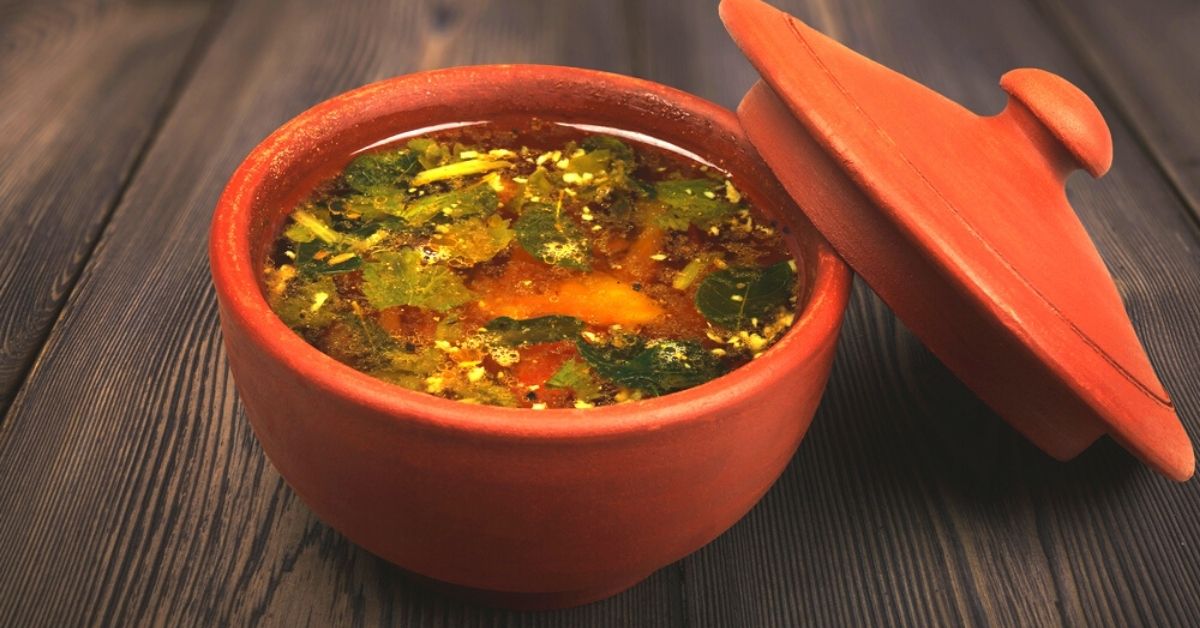TN Chef Makes Rasam Viral in US: The Story of South India’s Grand Old Dish
The medicinal properties of rasam came to light after award-winning chef, Arun Rajadurai from Princeton, decided to supply it as a complimentary dish along with food to COVID-19 patients in three hospitals.

On December 3, the United States of America woke up to a ‘new immunity booster’ that could help shield an individual from coronavirus. With a daily average order of 500-600 cups, the booster instantly went viral.
Seeing this, Indians let out a hearty laugh and also took pride in the lentil-based tangy vegetable stew that we have been savouring for eons.
The ‘booster’ is our very own top-echelon traditional item, routinely prepared in South Indian homes — Rasam.
The medicinal properties of Rasam came to light after award-winning chef, Arun Rajadurai, who works in Princeton, decided to supply it as a complimentary dish along with food to COVID-19 patients in three hospitals. The humble dish that can double up as a starter, soup or even a whole meal, received an overwhelming response.
Originally from Tamil Nadu’s Meensurutti village in Ariyalur, Arun bolstered the Rasam with an extra dash of ginger, turmeric and garlic. This combination provides instant relief to an itchy throat and helps build immunity.
Soon, this special combination was introduced in other branches of Anjappar Princeton in New York, New Jersey and Canada.
“I was experimenting at home when I made this. We never thought it would be such a hit,” Arun, who moved to New Jersey five years ago, told The Indian Express.

Apart from being a staple food, Rasam is also considered to be a superfood as it is packed with multiple nutrients. It is often tailor-made to suit health problems.
For the uninitiated, the spicy-peppery, sour Rasam is seasoned with black pepper, Rasam powder, tomatoes, tamarind and other home ground spices. It is important to note here that Rasam is different from Sambar due to its seasoning ingredients and extra fluid nature.
But before we further delve into its medicinal effectiveness, here’s a quick history about its origin.
Where it all began
Rasam is derived from a Tamil word ‘irasam’ and the Sanskrit word ‘rasa’, both words meaning essence or extract. It is believed to have originated in the 16th century in Madurai by Sourashtras, an immigrant community. They prefer calling it ‘Pulichaar’ which means tart or tamarind.
“Rasa in Sankrit means to extract. Rasam in the Tamil country is a thin extract of tuvar dal spiced in various ways, such as pepper, tamarind, lime, tomato, curry leaves, etc. It is poured on rice as the first course of a south Indian meal. Rasam is also called saar, saaru, chaaru and pulusu in other south Indian languages. The British colonials adopted it as a pungent soup and called mulligatawny,” writes Renowned Food Author and Historian KT Achaya in his book, ‘A Historical Dictionary of Indian Food’
Over the decades, the beloved Rasam came to be known by many names in South India. The dish is called Rasam in Tamil Nadu and Kerala, saaru in Karnataka, chaaru in Andhra Pradesh and saar in Maharashtra. Along with giving it a local name, every region also gave it its own twist to the flavour.
With 200 known varieties of Rasam, there are but minor differences in texture and flavour. Unlike, Rasam, saaru and chaaru have a thicker consistency with a touch of Saarina Pudi (a dry powder).
Health Benefits
The multiple health benefits of this dish can be decoded by examining certain ingredients used in it.
Often touted as ‘recovery food’, many grandmothers turned to Rasam as a home remedy to cure a cold and cough. Coriander seeds have anti-inflammatory properties. Meanwhile, ginger, turmeric and black pepper provide relief to sore throats and cold.
Adding raw garlic can help with circulatory ailments as well. Mustard and fenugreek are anti-oxidant.
Rasam comes handy for people with digestive issues. Ingredients like cumin, ginger and asafoetida facilitate easy digestion and prevent constipation. Tamarind is rich in dietary fibre that eases bowel movement.
The many variants added in the Rasam together provide minerals such as zinc, calcium, niacin, potassium and magnesium. Not to forget, Rasam is also full of Vitamin A and C.
Finally, the black pepper can also speed metabolism that in turn helps in weight loss.
A hot-piping Rasam certainly makes for quintessential comfort food.
Now that you are aware of the several benefits of Rasam, go ahead and devour this simple delicacy that is a powerhouse of flavours.
Edited by Yoshita Rao
If you found our stories insightful, informative, or even just enjoyable, we invite you to consider making a voluntary payment to support the work we do at The Better India. Your contribution helps us continue producing quality content that educates, inspires, and drives positive change.
Choose one of the payment options below for your contribution-
By paying for the stories you value, you directly contribute to sustaining our efforts focused on making a difference in the world. Together, let’s ensure that impactful stories continue to be told and shared, enriching lives and communities alike.
Thank you for your support. Here are some frequently asked questions you might find helpful to know why you are contributing?


This story made me
-
97
-
121
-
89
-
167











